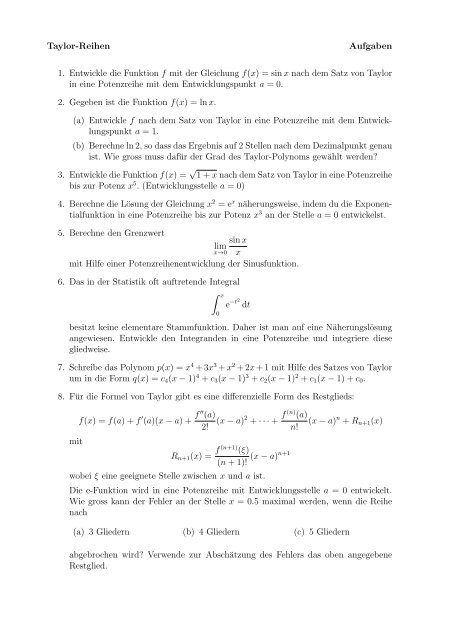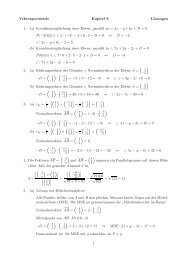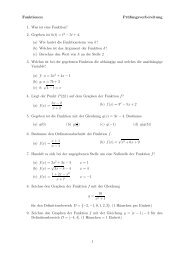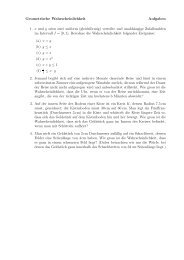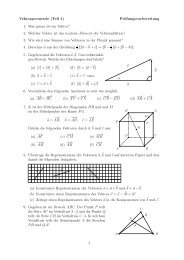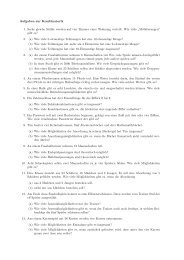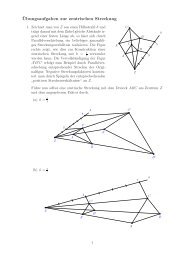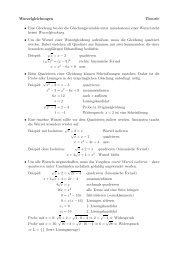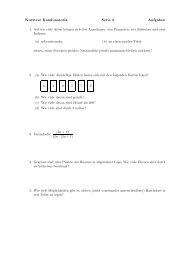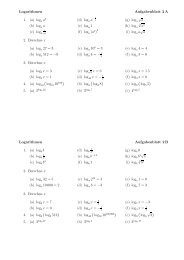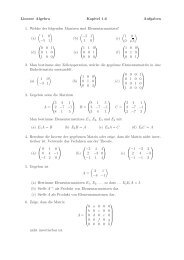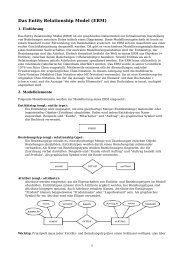Taylor-Reihen Aufgaben 1. Entwickle die Funktion f mit der ... - gxy.ch
Taylor-Reihen Aufgaben 1. Entwickle die Funktion f mit der ... - gxy.ch
Taylor-Reihen Aufgaben 1. Entwickle die Funktion f mit der ... - gxy.ch
Sie wollen auch ein ePaper? Erhöhen Sie die Reichweite Ihrer Titel.
YUMPU macht aus Druck-PDFs automatisch weboptimierte ePaper, die Google liebt.
<strong>Taylor</strong>-<strong>Reihen</strong><br />
<strong>Aufgaben</strong><br />
<strong>1.</strong> <strong>Entwickle</strong> <strong>die</strong> <strong>Funktion</strong> f <strong>mit</strong> <strong>der</strong> Glei<strong>ch</strong>ung f(x) = sin x na<strong>ch</strong> dem Satz von <strong>Taylor</strong><br />
in eine Potenzreihe <strong>mit</strong> dem Entwicklungspunkt a = 0.<br />
2. Gegeben ist <strong>die</strong> <strong>Funktion</strong> f(x) = ln x.<br />
(a) <strong>Entwickle</strong> f na<strong>ch</strong> dem Satz von <strong>Taylor</strong> in eine Potenzreihe <strong>mit</strong> dem Entwicklungspunkt<br />
a = <strong>1.</strong><br />
(b) Bere<strong>ch</strong>ne ln 2, so dass das Ergebnis auf 2 Stellen na<strong>ch</strong> dem Dezimalpunkt genau<br />
ist. Wie gross muss dafür <strong>der</strong> Grad des <strong>Taylor</strong>-Polynoms gewählt werden?<br />
3. <strong>Entwickle</strong> <strong>die</strong> <strong>Funktion</strong> f(x) = √ 1 + x na<strong>ch</strong> dem Satz von <strong>Taylor</strong> in eine Potenzreihe<br />
bis zur Potenz x 5 . (Entwicklungsstelle a = 0)<br />
4. Bere<strong>ch</strong>ne <strong>die</strong> Lösung <strong>der</strong> Glei<strong>ch</strong>ung x 2 = e x näherungsweise, indem du <strong>die</strong> Exponentialfunktion<br />
in eine Potenzreihe bis zur Potenz x 3 an <strong>der</strong> Stelle a = 0 entwickelst.<br />
5. Bere<strong>ch</strong>ne den Grenzwert<br />
sin x<br />
lim<br />
x→0 x<br />
<strong>mit</strong> Hilfe einer Potenzreihenentwicklung <strong>der</strong> Sinusfunktion.<br />
6. Das in <strong>der</strong> Statistik oft auftretende Integral<br />
∫ x<br />
0<br />
e −t2 dt<br />
besitzt keine elementare Stammfunktion. Daher ist man auf eine Näherungslösung<br />
angewiesen. <strong>Entwickle</strong> den Integranden in eine Potenzreihe und integriere <strong>die</strong>se<br />
gliedweise.<br />
7. S<strong>ch</strong>reibe das Polynom p(x) = x 4 + 3x 3 + x 2 + 2x + 1 <strong>mit</strong> Hilfe des Satzes von <strong>Taylor</strong><br />
um in <strong>die</strong> Form q(x) = c 4 (x − 1) 4 + c 3 (x − 1) 3 + c 2 (x − 1) 2 + c 1 (x − 1) + c 0 .<br />
8. Für <strong>die</strong> Formel von <strong>Taylor</strong> gibt es eine differenzielle Form des Restglieds:<br />
<strong>mit</strong><br />
f(x) = f(a) + f ′ (a)(x − a) + f ′′ (a)<br />
2!<br />
(x − a) 2 + · · · + f (n) (a)<br />
(x − a) n + R n+1 (x)<br />
n!<br />
R n+1 (x) = f (n+1) (ξ)<br />
(x − a)n+1<br />
(n + 1)!<br />
wobei ξ eine geeignete Stelle zwis<strong>ch</strong>en x und a ist.<br />
Die e-<strong>Funktion</strong> wird in eine Potenzreihe <strong>mit</strong> Entwicklungsstelle a = 0 entwickelt.<br />
Wie gross kann <strong>der</strong> Fehler an <strong>der</strong> Stelle x = 0.5 maximal werden, wenn <strong>die</strong> Reihe<br />
na<strong>ch</strong><br />
(a) 3 Glie<strong>der</strong>n (b) 4 Glie<strong>der</strong>n (c) 5 Glie<strong>der</strong>n<br />
abgebro<strong>ch</strong>en wird? Verwende zur Abs<strong>ch</strong>ätzung des Fehlers das oben angegebene<br />
Restglied.
<strong>Taylor</strong>-<strong>Reihen</strong><br />
Lösungen+<br />
<strong>1.</strong> f(x) = sin x ⇒ f(0) = 0<br />
f ′ (x) = cos x ⇒ f ′ (0) = 1<br />
f ′′ (x) = − sin x ⇒ f ′′ (0) = 0<br />
f ′′′ (x) = − cos x ⇒ f ′′′ (0) = −1<br />
f (4) (x) = sin x ⇒ f ′′′ (0) = 0<br />
. . .<br />
f(x) = f(a) + f ′ (a)(x − a) + f ′′ (a)<br />
2!<br />
(x − a) 2 + f ′′′ (a)<br />
(x − a) 3 + . . .<br />
3!<br />
a = 0 ⇒ sin(x) = 0 + 1 · x + 0 − 1 3! · x3 + 0 + 1 5! · x5 + 0 − 1 7! · x7 + . . .<br />
∞<br />
sin(x) = x − x3<br />
3! + x5<br />
5! − x7<br />
7! + · · · = ∑<br />
(−1) k x 2k+1<br />
(2k + 1)!<br />
2. (a) f(x) = ln x ⇒ f(1) = 0<br />
f ′ (x) = x −1 ⇒ f ′ (1) = 1<br />
f ′′ (x) = −x −2 ⇒ f ′′ (1) = −1<br />
f ′′′ (x) = 2x −3 ⇒ f ′′′ (1) = 2 = 2!<br />
f (4) (x) = −6x −4 ⇒ f (4) (1) = −6 = −3!<br />
f (5) (x) = 24x −5 ⇒ f (5) (1) = 24 = 4!<br />
. . .<br />
f(x) = f(a) + f ′ (a)(x − a) + f ′′ (a)<br />
2!<br />
k=0<br />
(x − a) 2 + f ′′′ (a)<br />
(x − a) 3 + . . .<br />
3!<br />
ln(x) = 0 + 1 · (x − 1) − 1 2! · (x − 1)2 + 2!<br />
3! · (x − 1)3 − 3!<br />
4! · (x − 1)4 + . . .<br />
ln(x) = (x − 1) −<br />
(x − 1)2<br />
2<br />
+<br />
(x − 1)3<br />
3<br />
o<strong>der</strong> <strong>mit</strong> <strong>der</strong> Substitution x − 1 → x:<br />
ln(x + 1) = x − x2<br />
2 + x3<br />
3 − x4<br />
4 + x5<br />
(b) s n =<br />
n∑<br />
(−1)<br />
k=1<br />
k+1 xk<br />
k<br />
n s n ln 2 | ln 2 − s n |<br />
10 0.64563 0.69315 0.04752<br />
20 0.66877 0.69315 0.02438<br />
30 0.67676 0.69315 0.01639<br />
40 0.68080 0.69315 0.01235<br />
49 0.70325 0.69315 0.01010<br />
50 0.68325 0.69315 0.00990<br />
51 0.70286 0.69315 0.00971<br />
−<br />
(x − 1)4<br />
4<br />
5 + · · · = ∞<br />
∑<br />
k=1<br />
+ · · · =<br />
k+1 xk<br />
(−1)<br />
k<br />
∞∑<br />
k+1 (x − 1)k<br />
(−1)<br />
k<br />
k=1
3. f (0) (x) = (1 + x) 1 2 ⇒ f (0) (0) = 1<br />
f (1) (x) = 1 2 (1 + x)− 1 2 ⇒ f (1) (0) = 1 2<br />
f (2) (x) = − 1 4 (1 + x)− 3 2 ⇒ f (2) (0) = − 1 4<br />
f (3) (x) = 3 8 (1 + x)− 5 2 ⇒ f (3) (0) = 3 8<br />
f (4) (x) = − 15(1<br />
+ 7 16 x)− 2 ⇒ f (4) (0) = − 15<br />
16<br />
f (5) (x) = 105(1<br />
+ 9 32 x)− 2 ⇒ f (5) (0) = 105<br />
32<br />
√<br />
1 + x = 1 +<br />
1<br />
2 x − 1<br />
4 · 2! x2 + 3<br />
8 · 3! x3 − 15<br />
16 · 4! x4 + 105<br />
32 · 5! x5 − . . .<br />
= 1 + 1 2 x − 1 8 x2 + 1 16 x3 − 5<br />
128 x4 + 7<br />
256 x5 − . . .<br />
4. e x ≈ 1 + x + x2<br />
2! + x3<br />
3!<br />
x 2 = e x<br />
x 2 ≈ 1 + x + x2<br />
2 + x3<br />
6<br />
6x 2 ≈ 6 + 6x + 3x 2 + x 3<br />
0 ≈ x 3 − 3x 2 + 6x + 6<br />
x ≈ −0.69889<br />
Zum Verglei<strong>ch</strong> <strong>die</strong> ”<br />
exakte“ Lösung: −0.7035<br />
5. lim<br />
x→0<br />
sin x<br />
x<br />
6. e −t2 = 1 + ( − t 2) +<br />
(<br />
)<br />
= lim x − x3 + x5 − x7 + . . .<br />
3! 5! 7!<br />
= lim 1 − x2<br />
x→0 x<br />
x→0 3! + x4<br />
5! − x6<br />
7! + . . . = 1<br />
( ) − t<br />
2 2 ( ) − t<br />
2 3 ( ) − t<br />
2 4<br />
+ +<br />
2! 3! 4!<br />
∞<br />
= 1 − t 2 + t4<br />
2! − t6<br />
3! + t8<br />
4! − · · · = ∑<br />
k=0<br />
(−1) k t2k<br />
k!
∫ x<br />
0<br />
e −t2 dt =<br />
=<br />
∫ x<br />
0<br />
∫ x<br />
0<br />
(1 − t 2 + t4<br />
2! − t6<br />
3! + t8<br />
1 dt −<br />
∫ x<br />
= [ t ] [ ]<br />
x t<br />
3 x − +<br />
0<br />
3<br />
0<br />
0<br />
∫ x<br />
t 4<br />
)<br />
4! − . . . dt<br />
∫ x<br />
t 2 dt +<br />
0 2! dt − t 6 ∫ x<br />
0 3! dt + 0<br />
[ t<br />
5 x [ t<br />
7 x [ t<br />
9 x<br />
− + − . . .<br />
5 · 2!]<br />
0<br />
7 · 3!]<br />
0<br />
9 · 4!]<br />
0<br />
= x − x3<br />
3 + x5<br />
5 · 2! − x7<br />
7 · 3! + x9<br />
9 · 4! − . . .<br />
7. p(x) = x 4 + 3x 3 + x 2 + 2x + 1 p(1) = 8 c 0 = 8/0! = 8<br />
p ′ (x) = 4x 3 + 9x 2 + 2x + 2 p ′ (1) = 17 c 1 = 17/1! = 17<br />
p ′′ (x) = 12x 2 + 18x + 2 p ′′ (1) = 32 c 2 = 32/2! = 16<br />
p ′′′ (x) = 24x + 18 p ′′′ (1) = 42 c 3 = 42/3! = 7<br />
p (4) (x) = 24 p (4) (1) = 24 c 4 = 24/4! = 1<br />
q(x) = (x − 1) 4 + 7(x − 1) 3 + 16(x − 1) 2 + 17(x − 1) + 8<br />
t 8<br />
4! dt − . . .<br />
8. A<strong>ch</strong>tung: In den Theorieunterlagen wurde das Restglied <strong>mit</strong> R n+1 bezei<strong>ch</strong>net. In<br />
<strong>der</strong> Formelsammlung wird es <strong>mit</strong> R n bezei<strong>ch</strong>net. Es hat dort also <strong>die</strong> glei<strong>ch</strong>e Nummer<br />
wie <strong>die</strong> Ordnung <strong>der</strong> zuletzt bere<strong>ch</strong>neten Ableitung. In <strong>der</strong> Lösung wird <strong>die</strong><br />
S<strong>ch</strong>reibweise aus <strong>der</strong> Formelsammlung verwendet.<br />
(a) 3 Glie<strong>der</strong>: (d.h. bis zur 2. Ableitung)<br />
R 2 (0.5) = f (3) (ξ)<br />
3!<br />
· (0.5 − 0) 3 = eξ<br />
6 · 1<br />
8 = 1 48 eξ <strong>mit</strong> ξ ∈ (0, 0.5)<br />
Für wel<strong>ch</strong>es ξ ∈ (0, 0.5) wird oben stehende Term maximal?<br />
ξ = 0.5 ⇒ 1 48 · e0.5 = 0.03434836<br />
Zum Verglei<strong>ch</strong>:<br />
2∑ 0.5 k<br />
∣ e0.5 −<br />
= |<strong>1.</strong>64872127 − <strong>1.</strong>625| = 0.02372127<br />
k! ∣<br />
k=0<br />
(b) R 3 (0.5) = f (4) (ξ)<br />
4!<br />
· (0.5 − 0) 4 = eξ<br />
24 · 1<br />
16 = 1<br />
384 eξ <strong>mit</strong> ξ ∈ (0, 0.5)<br />
ξ = 0.5 ⇒ 1<br />
384 · e0.5 = 0.00429354<br />
(c) R 4 (0.5) = f (5) (ξ)<br />
5!<br />
ξ = 0.5<br />
⇒<br />
· (0.5 − 0) 5 = eξ<br />
120 · 1<br />
32 = 1<br />
46 080 eξ <strong>mit</strong> ξ ∈ (0, 0.5)<br />
1<br />
46 080 · e0.5 = 0.00042935<br />
Moral: <strong>der</strong> maximal mögli<strong>ch</strong>e Fehler reduziert si<strong>ch</strong> bei jedem weiteren Summanden<br />
um etwa eine Dezimalstelle. Der wirkli<strong>ch</strong>e Fehler verhält si<strong>ch</strong> daher ni<strong>ch</strong>t s<strong>ch</strong>le<strong>ch</strong>ter.
<strong>Taylor</strong>-<strong>Reihen</strong><br />
Lösungen<br />
<strong>1.</strong> sin(x) = x − x3<br />
3! + x5<br />
5! − x7<br />
7! + . . .<br />
2. (a) f(x) = (x − 1) −<br />
(x − 1)2<br />
2<br />
+<br />
(x − 1)3<br />
3<br />
−<br />
(x − 1)4<br />
4<br />
3. √ 1 + x ≈ 1 + 1 2 x − 1 8 x2 + 3 16 x3 − 5<br />
128 x4 + 7<br />
256 x5<br />
4. x ≈ −0.69889<br />
sin x<br />
5. lim<br />
x→0 x = 1<br />
6.<br />
7.<br />
∫ x<br />
0<br />
e −t2 dt = x − x3<br />
3 + x5<br />
5 · 2! − x7<br />
7 · 3! + x9<br />
9 · 4! − . . .<br />
+ . . .<br />
8. (a) 0.03434836<br />
(b) 0.00429354<br />
(c) 0.00042935


